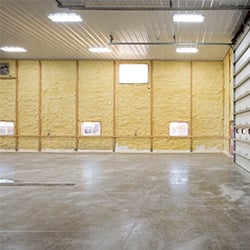Posts | Videos | Post Video | Building Features | Energy Efficiency | Insulation
Pole Barn Insulation: 4 Ways to Defend Your Building From Heat Loss
Cori grew up on her family's small grain and livestock operation in Northwest Indiana. In 2018, she graduated Summa Cum Laude with a Bachelor's degree in Business Administration & Marketing from Marian University Indianapolis. Having shown beef cattle for 12 years at the county, state, and national levels, Cori chose to pursue a career in agriculture. Today, she serves as the Marketing Content Creator on the FBi team. In her free time, Cori enjoys spending time with family and friends, watching sports, listening to live music, and traveling.
Winter is here, and Midwesterners know just how unpredictable it can be—sunny one day, snow-covered the next. While meteorologists and The Old Farmer’s Almanac try to predict it, no one can guarantee a mild season.
Some dread the cold; others enjoy the snow. However, we can all agree: high energy bills are never welcome.
In your stick-built home, you probably take simple steps to stay warm, such as sealing walk doors, adding rugs, or using extra heat sources. But what about your farm shop or man cave? Insulation is your first line of defense against heat loss.
While the upfront cost may seem high, investing in proper insulation lowers monthly energy bills and keeps your space comfortable. This article discusses R-value and the four types of pole barn insulation to consider for your post-frame building.
The Importance of R-Value in Pole Barn Insulation
In post-frame construction, R-value is the standard measure of an insulating material’s resistance to heat flow. The higher the R-value, the better your pole barn will retain heat and maintain energy efficiency.
 The optimal R-value for your post-frame building depends on several key factors:
The optimal R-value for your post-frame building depends on several key factors:
- Climate Zone: Cold regions require higher R-values.
-
HVAC System Type: Heating and cooling efficiency influences insulation needs.
- Pole Barn Size and Layout: Larger spaces or areas with high ceilings may require additional insulation.
Keep in mind that R-value alone doesn’t guarantee a warm, energy-efficient structure. Air infiltration also plays a critical role. A drafty post-frame building with a high R-value may feel colder than a smaller, airtight structure with a lower R-value.
Moreover, the effective R-value of walls or ceilings may differ from that of the insulation. Heat can bypass insulated areas through laminated columns, joists, or other framing members.
Working with a skilled post-frame builder ensures your insulation is installed correctly, maximizing R-value and boosting your pole barn’s energy efficiency.
4 Types of Pole Barn Insulation for Your Post-Frame Building
With R-value in mind, it’s time to explore the different insulation options for your post-frame building. Choosing the right insulating material can significantly impact energy efficiency, comfort, and long-term operating costs.
As you evaluate your options, consider these key questions:
-
Will the pole barn be heated?
- If so, how consistently will it be maintained at a reasonable temperature?
- Does your post-frame building have exposed trusses or a finished ceiling?
Your answers will help determine the most effective insulation type, ensuring your post-frame building stays energy-efficient and comfortable year-round.
1) Perimeter Slab Insulation
 Most post-frame buildings have concrete sitting on top of the ground. While the floor provides a stable foundation, the ground beneath has its own R-value, which can be compromised if not properly insulated.
Most post-frame buildings have concrete sitting on top of the ground. While the floor provides a stable foundation, the ground beneath has its own R-value, which can be compromised if not properly insulated.
Installing rigid board insulation around the perimeter helps retain heat. A 2-inch-thick board is placed vertically along the columns or horizontally beneath the flooring type.
If your pole barn features in-floor heating or sits above a high water table, we recommend insulating the entire floor.
Otherwise, heat can escape into the ground, reducing comfort and increasing energy costs.
2) Wall Insulation
The walls of your post-frame building act as barriers to harsh weather conditions.
Without wall insulation, heat transfer occurs regardless of the heating or cooling system used. Even if your furnace runs continuously, a poorly insulated pole barn will lose valuable heat. Simply put, you're throwing money down the drain.
Installing high-quality wall insulation minimizes heat transfer, lowers energy bills, and keeps your post-frame building comfortable and energy-efficient year-round.
Fiberglass Batt Insulation
 Fiberglass batts are one of the most popular choices for pole barns due to their affordability and ease of installation.
Fiberglass batts are one of the most popular choices for pole barns due to their affordability and ease of installation.
These long spans fit neatly between posts, creating continuous coverage with minimal gaps or air leaks.
For optimal performance, pair the fiberglass batts with a vapor barrier. This impermeable membrane reduces condensation inside the post-frame building.
Vapor barriers protect insulation from moisture damage, maintaining its R-value and extending the lifespan of your pole barn.
Vinyl-Backed Insulation
Vinyl-backed insulation is a type of fiberglass batt with a white coating on the backside. Typically installed between framing members, it can sag if not properly supported.
Compared to standard fiberglass batts, vinyl-backed insulation is thinner and has a lower R-value. Installation can be more challenging, and the effective R-value depends on the thickness of the material.
Spray Foam Insulation
 Spray foam insulation has gained popularity as a high-performance alternative to fiberglass batts. It expands to fill cracks and gaps within your pole barn, sealing air leaks and moisture for year-round comfort.
Spray foam insulation has gained popularity as a high-performance alternative to fiberglass batts. It expands to fill cracks and gaps within your pole barn, sealing air leaks and moisture for year-round comfort.
Because specialized chemicals and equipment are used, spray foam insulation should be installed by a professional contractor.
Keep in mind that spray foam insulation can be difficult to remove. Furthermore, some products are not tested or approved for metal panels.
Certain suppliers may limit warranty coverage when spray foam is used. Always consult your post-frame builder before making a final decision.
Rigid Board Insulation
Rigid board insulation is installed directly beneath the steel siding in post-frame buildings. It provides continuous coverage and a high R-value, reducing air infiltration and improving overall energy efficiency.
Not all rigid board insulation products are the same. Choose one specifically approved for exposed applications to ensure durability and long-term performance.
Proper selection and installation of rigid board insulation help maintain a comfortable pole barn interior while reducing energy bills.
Building Wrap
 While not technically insulation, building wrap serves as an optional convection and moisture barrier in post-frame construction.
While not technically insulation, building wrap serves as an optional convection and moisture barrier in post-frame construction.
Installed beneath the steel siding of your pole barn, it works alongside your wall insulation to reduce air infiltration, enhance energy efficiency, and maintain a comfortable temperature.
Before adding building wrap, consider local building codes, steel gauge, and the type of insulation in your post-frame building to determine its value.
For guidance on compliance, consult your local building department or the Authority Having Jurisdiction (AHJ) in your area.
3) Attic Insulation
 Attic insulation is most effective when your pole barn has drywall or a finished ceiling. The most common options are fiberglass batts and blown insulation.
Attic insulation is most effective when your pole barn has drywall or a finished ceiling. The most common options are fiberglass batts and blown insulation.
Blown insulation is applied with specialized equipment, allowing the loose-fill material to create an airtight barrier between ceiling joists and truss bottom chords.
It’s easy to install, adapts to any R-value, and conforms to irregular or hard-to-reach spaces.
For optimal energy savings, Energy Star recommends an attic insulation level of R-38 (approximately 10–14 inches) in post-frame buildings.4) Roof Insulation
 An insulated metal roof offers a cost-effective alternative to a full interior liner package. Roof insulation is installed under the metal roofing panels with exposed truss members.
An insulated metal roof offers a cost-effective alternative to a full interior liner package. Roof insulation is installed under the metal roofing panels with exposed truss members.
Rigid board insulation, such as Thermax®, is a popular choice for pole barn roofs. This insulating material eliminates the need for interior finishes.
For additional protection, a radiant barrier resists heat transfer by absorbing and slowing heat flow.
Radiant barriers are most effective in attics or under metal roofing panels of air-conditioned structures. One side must be facing an air space to function properly.
Which Type of Pole Barn Insulation is Right for You?
Ultimately, the way you insulate your pole barn will depend on your needs, budget, and how you use the space.
While upfront costs may seem high, focusing on climate-controlled areas ensures maximum energy efficiency. Properly installed insulation reduces heat loss, improves comfort, and lowers energy bills.
Are you ready to build with confidence? Request a free pole barn quote here.
Do you want to upgrade your existing post-frame building? Request a free pole barn renovation quote here.
Additional Resources:
Barndominium Insulation Options for Maximum Efficiency
Can You Add Batt Insulation to an Existing Pole Barn?
Can You Spray Foam an Existing Pole Barn?
Ultimate Guide to Pole Barn Insulation
Do you have more questions about pole barn insulation that are not covered in this article? If you need help designing and planning, please contact FBi Buildings at 800.552.2981 or click here to email us. If you're ready to get a price, click here to request a quote, and a member of our Customer Engagement Team will help you determine the next steps of your project.



